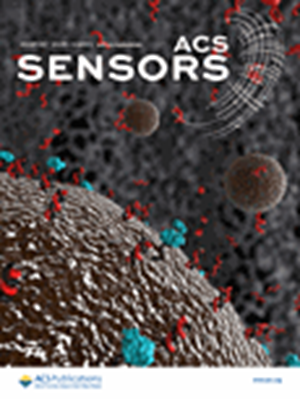智能三明治:一种基于琼脂糖-壳聚糖-琼脂糖(ACA)三层生物膜的柔性传感装置,用于现场监测大肠杆菌。
IF 9.1
1区 化学
Q1 CHEMISTRY, ANALYTICAL
引用次数: 0
摘要
便携式、高性价比和耐用的薄膜传感器对于实时检测大肠杆菌、确保安全饮用水和公共卫生至关重要。在这项工作中,我们开发了一种使用琼脂糖-壳聚糖-琼脂糖(ACA)三明治生物膜的固态柔性传感装置,用于水中大肠杆菌的选择性比色检测。壳聚糖作为一种人工酶,在过氧化氢(H2O2)存在下催化3,3',5,5'-四甲基联苯胺(TMB)的氧化,具有过氧化物酶样活性。将ACA生物膜与大肠杆菌孵育后,琼脂糖层被大肠杆菌产生的β-半乳糖苷酶降解。降解的发生是由于β-1,4-糖苷键的断裂。这暴露了底层的壳聚糖层,增强了催化活性,在30分钟内触发了TMB氧化引起的可见颜色变化。该设备达到了6.8 CFU/mL的高灵敏度检测限,在真实样品中具有出色的准确性,进一步支持基于android的智能手机辅助检测。开发的固态柔性ACA生物膜为现场大肠杆菌检测提供了一种新颖、快速、可靠的解决方案,结合了灵敏度、稳定性和易用性。本文章由计算机程序翻译,如有差异,请以英文原文为准。
Smart-Sandwich: A Thin Flexible Sensing Device Based on an Agarose-Chitosan-Agarose (ACA) Triple-Layer Biofilm for Onsite Monitoring of Escherichia coli.
Portable, cost-effective, and durable thin-film sensors are essential for real-time E. coli detection, ensuring safe drinking water and public health protection. In this work, we developed a solid-state, flexible sensing device using an agarose-chitosan-agarose (ACA) sandwich biofilm for the selective colorimetric detection of E. coli in water. The chitosan in ACA biofilm functions as an artificial enzyme, exhibiting peroxidase-like activity, which catalyzes the oxidation of 3,3',5,5'-tetramethylbenzidine (TMB) in the presence of hydrogen peroxide (H2O2). Upon incubating the ACA biofilm with E. coli, the agarose layers undergo enzymatic degradation by the β-galactosidase enzyme produced by E. coli. The degradation takes place due to the cleavage of β-1,4-glycosidic bonds. This exposes the underlying chitosan layer which enhances the catalytic activity, triggering a visible color change due to TMB oxidation within 30 min. The device achieves a highly sensitive detection limit of 6.8 CFU/mL, with excellent accuracy in real samples, further supported by android-based, smartphone-assisted detection. The developed solid-state, flexible ACA biofilm offers a novel, rapid, and reliable solution for onsite E. coli detection, combining sensitivity, stability, and ease of use.
求助全文
通过发布文献求助,成功后即可免费获取论文全文。
去求助
来源期刊

ACS Sensors
Chemical Engineering-Bioengineering
CiteScore
14.50
自引率
3.40%
发文量
372
期刊介绍:
ACS Sensors is a peer-reviewed research journal that focuses on the dissemination of new and original knowledge in the field of sensor science, particularly those that selectively sense chemical or biological species or processes. The journal covers a broad range of topics, including but not limited to biosensors, chemical sensors, gas sensors, intracellular sensors, single molecule sensors, cell chips, and microfluidic devices. It aims to publish articles that address conceptual advances in sensing technology applicable to various types of analytes or application papers that report on the use of existing sensing concepts in new ways or for new analytes.
 求助内容:
求助内容: 应助结果提醒方式:
应助结果提醒方式:


